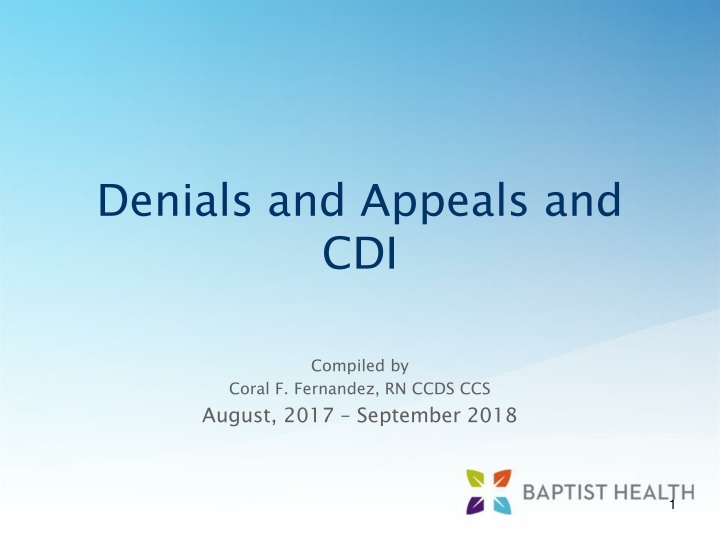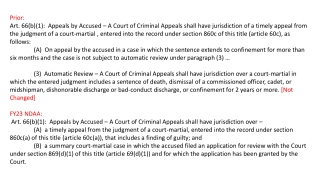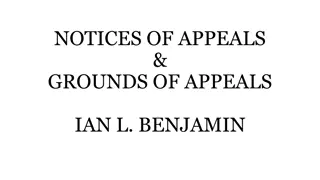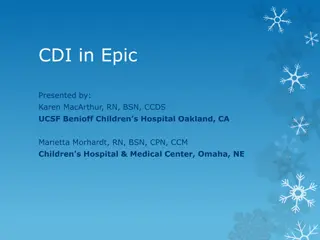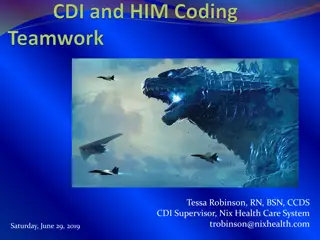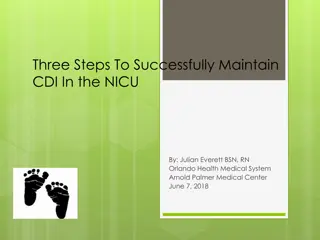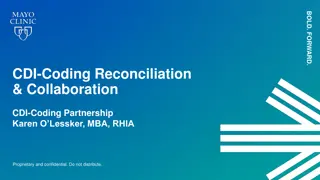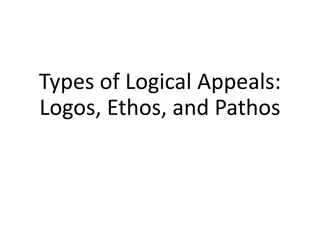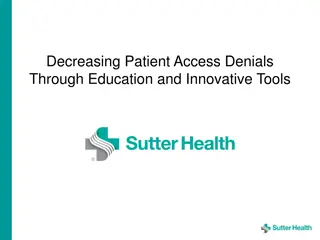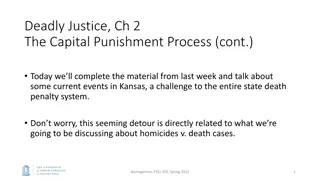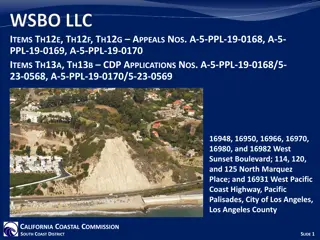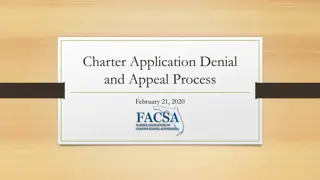Insights into Denials, Appeals, and CDI Practices
Explore the comprehensive guide compiled by Coral F. Fernandez, RN, CCDS, CCS, shedding light on the life cycle of a claim, denials, appeals, and the significant financial impact they have on healthcare organizations. Understand the reasons for claim denials, the potential losses incurred, and strategies to mitigate denials for optimal revenue cycle management.
Download Presentation

Please find below an Image/Link to download the presentation.
The content on the website is provided AS IS for your information and personal use only. It may not be sold, licensed, or shared on other websites without obtaining consent from the author.If you encounter any issues during the download, it is possible that the publisher has removed the file from their server.
You are allowed to download the files provided on this website for personal or commercial use, subject to the condition that they are used lawfully. All files are the property of their respective owners.
The content on the website is provided AS IS for your information and personal use only. It may not be sold, licensed, or shared on other websites without obtaining consent from the author.
E N D
Presentation Transcript
Denials and Appeals and CDI Compiled by Coral F. Fernandez, RN CCDS CCS August, 2017 September 2018 1
INTRODUCTION Coral F. Fernandez, RN CCDS CCS 27 years with Baptist 2 years as a file clerk in HIM (prior to EMR) 25 as an RN 18 years in CDI 2 years as System CDI Auditor/Educator Lifelong learner Compulsive reader Insatiably curious English language enthusiast 2
Life cycle of a claim 1. Services rendered patient diagnosed and treated 2. Charges entered 3. Coding 3
Life cycle of a claim 4. Adjudication for expected reimbursement the billing system calculates what the payment should be, Medicare expected reimbursement based on APC and MS-DRG, other payers expected reimbursement is based on the modeling of each contract for example, if the insurer pays lab visits at 80% of charges, the billing system will take that into account in determining expected reimbursement 4
Life cycle of a claim 5. Editing and correction of claim claims scrubbing fixes duplicate/illogical/invalid coding, modifier requirements, coverage determinations, missing codes 6. Billing claim is submitted to the payer and accepted and paid, accepted and denied, or partially paid/denied 7. Collections and appeals 5
Denials A denial is any claim paid less than expected. According to The Advisory Board, denials cost health care organizations about 3% of their net revenue stream (2013). Roughly 67% of all denials are appealable. It is estimated that around 90% of all denials are preventable. 6
Losses from denials Healthcare organizations' annual losses from denial write-offs range from as little as 1% of net patient revenue to as high as 5%. For an average 300-bed organization, 1 percent of net patient revenue can equate to $2 million to $3 million annually. - McKesson 7
Some reasons for denial of claim Technical double billed, visits should have been combined, etc. Medical necessity, prior authorization, late notification, length of stay, referrals, utilization review Experimental and/or investigational treatments, new technologies Services not covered (payer contract defined or not?), bundling Services billed as inpatient that should have been billed as outpatient and vice versa 8
Some reasons for denial of claim Waited too long to file the claim Proper codes are missing (incomplete, invalid, don t correspond to the treatment rendered) Insurance company lost the claim and then the claim expired Preauthorization Patient did not acquire referral from a physician Two services provided in one day Ran out of authorized sessions Authorization time ran out Patient changed insurance plan Patient lost coverage (late in paying COBRA, for example) Claim sent to incorrect managing company Services rendered at the wrong location Provider isn t enrolled with the insurance company Patient has an out-of-state insurance plan 9
Some reasons for denial of claim Coding incorrect code assignment, errors in sequencing, coding separately things that should have been combined into one code, invalid diagnosis or procedure codes Clinical validity of diagnosis (-es), clinical criteria of provider different than clinical criteria of insurer 10
Medicare Denials Process From CMS.gov Appeals Levels Redetermination by a Medicare contractor (MAC) Reconsideration by a Qualified Independent Contractor (QIC) Hearing by an Administrative Law Judge (ALJ) Review by the Medicare Appeals Council Judicial Review in Federal District Court 1. 2. 3. 4. 5. 11
Statistics March, 2017 from Becker s Hospital Review denial rates for hospitals with 250-400 beds Northern Plains 10.58 percent South Central 8.88 percent Midwest 7.89 percent Southern Plains 7.72 percent Pacific 7.58 percent Northeast 7.21 percent Mountain 7.18 percent Southeast 7.14 percent 12
Inpatient Coding Denials and Appeals 13
DRG Validation Coding vs. Clinical ICD-10-CM Official Coding Guidelines for Coding and Reporting, effective October 1, 2016, Section I. Conventions for the ICD-10-CM 19. Code assignment and Clinical Criteria The assignment of a diagnosis code is based on the provider s diagnostic statement that the condition exists. The provider s statement that the patient has a particular condition is sufficient. Code assignment is not based on clinical criteria used by the provider to establish the diagnosis. 14
Code Assignment & Clinical Criteria Guideline 19 Explanation by Nelly-Leon Chisen at an AHIMA Clinical Coding Meeting This guideline was created to separate coding and clinical validation so RAC denials related to clinical validation would not be labeled as coding errors Clinical validation is a separate function, but it s a hospital s decision on how to handle this from a coding perspective Payers do have specific clinical guidelines which have to be followed 15
Remember The inpatient coder has NO CHOICE but to code what is documented in the record as a diagnosis by the provider. 16
DRG Validation vs. Clinical Validation The distinction is described in the Centers for Medicare & Medicaid (CMS) definition of clinical validation from the Recovery Audit Contractors Scope of Work document and cited in the AHIMA Practice Brief ("Clinical Validation: The Next Level of CDI") published in the August issue of JAHIMA: "Clinical validation is an additional process that may be performed along with DRG validation. Clinical validation involves a clinical review of the case to see whether or not the patient truly possesses the conditions that were documented in the medical record. Clinical validation is performed by a clinician (RN, CMD, or therapist). Clinical validation is beyond the scope of DRG (coding) validation, and the skills of a certified coder. This type of review can only be performed by a clinician or may be performed by a clinician with approved coding credentials." 17
CDI and Coding If clinical indicators are supportive of a particular diagnosis but not strongly supportive, a CDI query may help avoid a denial for claim after billing. Unless there is an after discharge review process in place, the only way the CDS is going to be notified that a CDI query may help avoid a denial for claim is if the inpatient coders communicate this. TEAMWORK 18
The Bigger Picture What attracts the attention of payers at the end of a patient s stay? Short stay, long stay Specific principal diagnoses Specific DRGs Claims with only one CC or MCC are denied more often than claims with multiple CCs and/or MCCs 19
CDI in the bigger picture What s wrong with the one and done CDI program? If YOU were an auditor for an insurance company and it was your job to look for ways to save the company money by looking for claims to deny (for whatever reason), wouldn t you look for claims with only ONE CC or MCC to minimize the amount of work you had to do to decrease the amount paid out to the provider? As an auditor, you d only have to deny ONE diagnosis successfully to change the reimbursement for that claim. 20
CDI in the bigger picture What s wrong with the one and done CDI program? Claims with only one CC or MCC are denied more often than claims with multiple CCs and/or MCCs. CDI queries that add additional CCs and/or MCCs to a patient s problem list are INVALUABLE. 21
Journal of AHIMA Clinical Validation: The Next Level of CDI July 2016 (There is also an article from Journal of AHIMA entitled, Taking Coding to the Next Level through Clinical Validation ) From 2013 Practice Brief, Guidelines for Achieving a Compliant Query Practice : A query is appropriate when the health record documentation provides a diagnosis without underlying clinical validation. When a practitioner documents a diagnosis that does not appear to be supported by the clinical indicators in the health record, it is currently advised that a query be generated to address the conflict or that the conflict be addressed through the facility s escalation process. 22
Journal of AHIMA Clinical Validation: The Next Level of CDI July 2016 (There is also an article from Journal of AHIMA entitled, Taking Coding to the Next Level through Clinical Validation ) It is also important to note that clinical validation is a somewhat subjective concept as practitioners often disagree how to define conditions . CMS 2013 Recovery Audit Contractor Scope of Work: Clinical validation involves a clinical review of the case to see whether or not the patient truly possesses the conditions that were documented in the medical record. Clinical validation is performed by a clinician. 23
Journal of AHIMA Clinical Validation: The Next Level of CDI July 2016 Determining the clinical validity of a reported condition is subjective, which is why denials are plentiful. CMS only states, As with all codes, clinical evidence should be present in the medical record to support code assignment. Organizations are also well served to develop internal guidelines defining those diagnoses most vulnerable to denials. The goal of these guidelines is to promote consistency among CDI and coding professionals in identifying diagnoses that appear to lack sufficient clinical evidence. 24
Organizations are also well served to develop internal guidelines defining those diagnoses most vulnerable to denials... 25
Empirical Treatment EMPIRICAL TREATMENT: - medical treatment that is given on the basis of the doctor's observations and experience 27
Dont be afraid to point out the seemingly obvious This letter is in response to the audit findings forwarded to us by your office. We disagree with the recommendation to delete code J96.01, (Acute respiratory failure with hypoxia) as a secondary diagnosis. Per ER record, patient with history of COPD with complaints of worsening shortness of air at rest, supposed to be on O2 but has been unable to afford it after insurance stopped covering it. In determining his need for continued oxygen supplementation at discharge, Mr. Smith s oxygen saturations were measured on room air at rest. This resulted in oxygen saturations measured 85% - 88%. Patient was discharged with home oxygen. 28
DRG Validation vs. Clinical Validation AUDITOR/EDUCATOR FOR BAPTIST HEALTH SYSTEM: The notification from The Insurer is labeled, DRG Validation Worksheet. Is this denial based on coding guidelines or is it based on a clinical validation audit? If this is a clinical validation audit, The Insurer would be better served by a representative who is clinically educated and trained. This auditor, on behalf of Baptist Health System, reads the qualifications of the representative for The Insurer as RHIA, CCS. The RHIA is a professional certification administered by the American Health Information Management Association (AHIMA) and passing the exam results in licensure for health information management. Eligibility for the RHIA includes successful completion of at least a baccalaureate level degree in an accredited Health Information Management program and a passing score on the exam, offered by AHIMA. The CCS (Certified Coding Specialist) is also a certification offered by AHIMA. This level of higher education and certification is admirable, however RHIA and CCS are not clinically based. Baptist Health System respectfully requests that, if this denial is indeed based on a clinical validation audit, The Insurer have this claim and the medical records submitted reviewed by a clinician. 29
Dont be afraid to point out the seemingly obvious INSURER: After the left heart cath, the cardiologist documented that this patient has a Type II NSTEMI in the setting of V.T. This patient was diagnosed as having a NSTEMI, taken for cardiac cath, had an attempt at PTCA and medication adjustment per the Cardiology team. It was noted that the physician documented non ST elevation myocardial infarction in the provided medical record. The hospital has coded a subendocardial infarction or NSTEMI on this claim based on an elevation of troponin above the range of normal. 30
Dont be afraid to point out the seemingly obvious BAPTIST AUDITOR/EDUCATOR: The insurer s letter dated 04/25/2018 includes, The hospital has coded a subendocardial infarction or NSTEMI on this claim based on an elevation of troponin above the range of normal. Baptist Health Lexington has coded an NSTEMI based on physician interpretation of this individual s clinical picture and physician documentation thereof. 31
Dont be afraid to point out the seemingly obvious INSURER: To confirm the diagnosis of NSTEMI the medical record is examined for new ischemic changes on serial EKGs, a rising pattern of troponin levels, an appropriate clinical picture, and confirmation of the diagnosis by a cardiologist. BAPTIST AUDITOR/EDUCATOR: Confirmation of the diagnosis of NSTEMI by a cardiologist is not required, however, in this case, NSTEMI was documented by three cardiologists and a hospitalist. 32
Dont be afraid to point out the seemingly obvious INSURER: On review of the medical record there was no history of dementia and the physician did not document any dementia. BAPTIST AUDITOR/EDUCATOR: In fact, Dr. John Q. Public, MD documented this very thing in his progress note dated 05/04/2017. Please see the screen clipping below. A copy of this progress note will be sent with this letter. 33
Dont be afraid to point out the seemingly obvious INSURER: One would expect to find consistent documentation of the diagnosis throughout the record. BAPTIST AUDITOR/EDUCATOR: The present on admission indicator listed for DIAGNOSIS on PATIENT s claim is NO. One would not expect to see evidence supporting this diagnosis on admission or documentation throughout the record that the diagnosis is assumed or likely, because the present on admission indicator for that particular diagnosis was reported as NO. DIAGNOSIS was not present on admission. 34
Dont be afraid to point out the seemingly obvious BAPTIST AUDITOR/EDUCATOR: As always, Baptist Health System appreciates The Insurer s careful review of medical record documentation and respectful attention to correspondence pertaining to the appeals process. 35
Sepsis 1, Sepsis 2, and Sepsis 3 1. Bone, R.C., Balk, R.A., Cerra, F.B. et al. Definitions for sepsis and organ failure and guidelines for the use of innovative therapies in sepsis. The ACCP/SCCM Consensus Conference Committee. American College of Chest Physicians/Society of Critical Care Medicine. Chest. 1992; 101: 1644 1655 2. Levy, M, et al. 2001 SCCM/ESICM/ACCP/ATS/SIS International Sepsis Definitions Conference. Int Care Med (2003) 29:530-538. 3. Singer, M, et al. The Third International Consensus Definitions for Sepsis and Septic Shock. JAMA. 2016; 315(8):801-810. 36
Recent Denial Arguments BHS has received dozens of denials based on patients not meeting sepsis criteria as outlined by the Sepsis 3 criteria. Sepsis 3 criteria were SUGGESTED as criteria which SHOULD replace clinical criteria outlined in Sepsis 2 in an article published by JAMA in February 2016. BHS has received some denials for sepsis based on patients not meeting Sepsis 3 criteria on patients whose hospitalizations occurred prior to February 2016. BHS has received denials which included statements to the effect that the American Medical Association has now defined sepsis as organ dysfunction caused by a dysregulated response to infection. BUT 37
Quotes from the Sepsis 3 article, published by JAMA February, 2016 The task force recognized that no current clinical measures reflect the concept of a dysregulated host response. Interestingly, in 2016, ACP Hospitalist interviewed Dr. Clifford S. Deutschman, MS, MD, co-chair of Sepsis-3 and a professor of pediatrics and molecular medicine at Hofstra-Northwell School of Medicine in Hempstead, N.Y. In this interview, Dr. Deutschman said, If you want to absolutely 100% without fail identify a patient who has sepsis, you can't.... Sepsis is life-threatening organ dysfunction caused by a dysregulated host response to infection. Relatively straightforward and clinically pretty much useless and, nothing we're saying supersedes the judgment of a good clinician. 38
Recent Denial Arguments Even when the appeal author, writing on behalf of BHS, argues that the patient met sepsis criteria for organ dysfunction caused by a dysregulated response to infection as evidenced by a SOFA score of 2 or greater, the insurers often send another denial letter (second level) negating the clinical application of the SOFA score. 39
Recent Denial Arguments INSURER: Though the facility reviewer noted a PF Ratio of <400 in the appeal letter, this reviewer is unable to find supporting physician documentation of a PF Ratio in the medical record as provided. Therefore, we are unable to determine if the physician used PF Ratio criteria in the diagnosis of sepsis. 40
Recent Denial Arguments BAPTIST AUDITOR/EDUCATOR: To assert that a physician must not only take PF ratio into account in diagnosing sepsis but must also document that consideration is ridiculous. This auditor has been unable to find professional guidelines dictating to the physician that he or she document every aspect of medical decision making in arriving at a diagnosis and treatment plan. The clinical gestalt required of a physician in arriving at a diagnosis cannot be reduced, especially by a non-physician, to determining which aspects of a patient s clinical picture are relevant. 41
DEFINITIONS GESTALT: An organized whole that is perceived as more than the sum of its parts This auditor has been unable to find professional guidelines dictating to the physician that he or she document every aspect of medical decision making in arriving at a diagnosis and treatment plan. The clinical gestalt required of a physician in arriving at a diagnosis cannot be reduced, especially by a non-physician, to determining which aspects of a patient s clinical picture are relevant. 42
DEFINITIONS GESTALT: is a sensory interpretation that is greater than the sum of its parts, gestalt identification is the process by which healthcare practitioners organize clinical perceptions into specific diagnostic ideas. Gestalt is clearly not intuition. It is the meticulous acquisition of complex cognitive skills. 43
DEFINITIONS GESTALT: the ability to recognize patterns of disease perceptual grouping Amidst the explosion of technological advancement in medicine, the ability of the physician s mind cannot be replicated. 44
Recent Denial Arguments INSURER: The appeal letter references a P/F ratio of 348; however, the physician does not document the P/F ratio nor its significance. BAPTIST AUDITOR/EDUCATOR: This auditor, writing on behalf of Baptist Health System, finds no opinion whatsoever in the referenced article Singer, M, et al. The Third International Consensus Definitions for Sepsis and Septic Shock. JAMA. 2016; 315(8):801-810. regarding the recommendation of or necessity for physician documented interpretation of clinical indicators of organ failure (as outlined in the Sequential Organ Failure Assessment Score table) when that physician has diagnosed sepsis. 45
Every denial letter must be carefully reviewed Mr. Jones reported fever to 103.9 prior to coming to the hospital with rigors and chills. His vital signs on presentation included oral temp 101.1, pulse 112, respirations 24, blood pressure 109/43. The INSURER included infectious source, a NORMAL WBC count, and NORMAL respiratory rate of 20 in his/her findings. 46
Every denial letter must be carefully reviewed Mr. Jones had WBCs 11.18 on admission which increased to 13.12 the following day, neutrophils 88.9%, lactate 1.4, and CRP 10.44 on admission which increased to 22.76 the following day. The INSURER included a NORMAL WBC count from the day of admission but did not address other pertinent labs. 47
Every denial letter must be carefully reviewed Actually, sepsis was documented clearly and consistently in the ED, History and Physical, progress notes, AND discharge summary. The INSURER wrote that sepsis was documented in the discharge summary. 48
Every denial letter must be carefully reviewed Actually, the patient met both the insurer s criteria for acute respiratory failure as well as Baptist Health System criteria for acute respiratory failure. The INSURER wrote that criteria were not met for acute respiratory failure. 49
Recent Denial Arguments INSURER: In the discharge summary, the physician stated, Principal problem: Diabetic ketoacidosis without coma associated with diabetes mellitus due to underlying condition. The physician stated in the discharge summary that the presenting problem was diabetic ketoacidosis. 50
